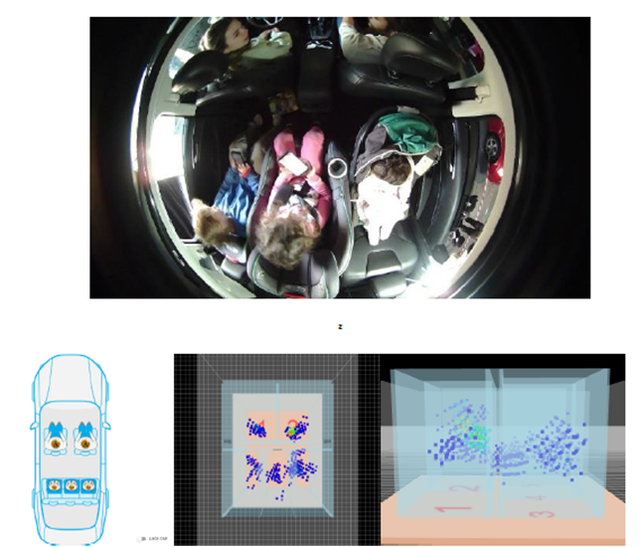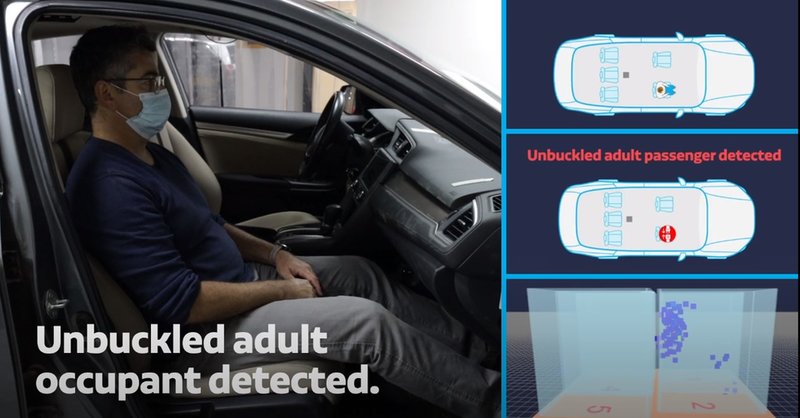THOUGHT LEADERSHIP
Sponsored by Vayyar
Higher Safety Ratings with Less Complexity and Lower Costs
Subtitle
An emergency drill onboard AIDAsol cruise ship in 2019. Image: MikhailBerkut / Shutterstock.com
Cost & complexity: the conundrum for carmakers
Today’s hardware-defined cars are rapidly transforming into software-defined transportation platforms.
As the modern car becomes crowded with technology, automotive OEMs must grapple with the complexity and development risk created by multiple development languages, operating systems, and software structures.
They face the same challenge on the hardware level. The modern car already houses as many as 200 sensors, more than double the amount from just two years ago. Electronics currently account for 35% of overall vehicle cost, projected to rise to 50% by 2030.
When it comes to safety, the problem is especially acute, since meeting rapidly rising standards is critical to commercial success and often compulsory. One area where this is particularly noticeable is the vehicle cabin. After decades of remaining essentially unchanged, it’s now becoming the lynchpin of redefined safety standards. Upcoming Euro NCAP protocols will require in-cabin Child Presence Detection (CPD) to prevent ‘hot car’ incidents, along with new scoring for Driver Monitoring Systems (DMS) and Occupant Status Monitoring (OSM).


Up until now, automakers have addressed rising standards with single-function sensors and stop-gap solutions. But deploying more sensors, and supporting them with a plethora of associated wiring, software, SOP programs and integration efforts, is uneconomical and ultimately unsustainable.
Fortunately, advances in sensor technology are now giving OEMs the opportunity to leverage a unified platform that simultaneously supports the widest possible range of safety applications to meet both existing and emerging standards.
4D imaging radar: multifunctionality on a single-chip platform
Vayyar’s leading-edge 4D Radar-on-Chip (RoC) technology allows automakers to move beyond the paradigm of one sensor per application by providing the industry’s only in-car solution that delivers multifunctionality on a single-chip platform. Just one affordable sensor can award vehicles up to 10 Euro NCAP safety points, more than 25% of the maximum possible in-car score.

Built around a 60GHz MIMO (Multiple Input Multiple Output) array of up to 48 antennas, one RFIC covers the entire cabin (up to eight occupants across three complete seating rows), enabling the operation of multiple advanced applications on-chip. It distinguishes between people and objects and between adults and children, detecting dimensions, posture, position and vital signs, while protecting privacy. The platform is unaffected by poor lighting and can identify a baby in a Child Restraint System (CRS) hidden under a blanket, or a child in any of the footwells.

An ultra-wide field of view and exceptionally high resolution are the cornerstones of Vayyar’s multifunctionality on a single-chip platform, which has three distinct aspects:
- Reducing the number of sensors required for each application.
- Supporting multiple applications simultaneously on a single chip.
- Giving automakers the flexibility to scale to future safety applications.
Ben Bouldin is Royal Caribbean’s vice president sales for Europe Middle East and Africa. Image: Royal Caribbean
One chip, ten points
To meet Euro NCAP’s upcoming standards, Vayyar’s affordable in-cabin safety ‘combo’ solution addresses the requirements for both CPD and two-row Seat Belt Reminders (SBR). It’s based on direct sensing supported by rich, high-resolution occupant data, preventing false alarms. The comprehensive CPD functionality qualifies any vehicle for the full four points in the Euro NCAP 2023 category and is available now to address the upcoming requirement.

But Vayyar’s multifunctionality on a single-chip platform goes beyond this core combo. The platform enables automakers to seamlessly develop applications over an advanced point cloud API. These include automatic airbag disabling, driver monitoring and occupant status, eCall functionality intruder detection and more. Together with CPD, these applications provide vehicles with up to 10 in-car safety points. Automakers can also rapidly develop and deploy future applications over-the-air (OTA) to meet emerging safety requirements, without needing to initiate additional SOP programs.

Just one multifunctional sensor replaces seven or more standard in-car sensors, slashing both costs and complexity since it requires less hardware, software, wiring, power consumption and integration efforts, along with fewer ECUs. It also lowers development risk, reduces the number of new SOP programs, shortens TTM and ensures an economical BOM.

Ben Bouldin is Royal Caribbean’s vice president sales for Europe Middle East and Africa. Image: Royal Caribbean
Multifunctional and Multilayered
The unified software-hardware platform is a central aspect of Vayyar’s solution, allowing automakers to tackle numerous software challenges ranging from increased complexity to reduced flexibility with a mature, full-stack system that addresses all aspects of the development and integration processes.
With an integrated DSP and MCU, all software is embedded on-chip, and processing and computing are performed at the edge, including execution of advanced radar algo. This allows automakers to focus more on image processing and machine learning, and less on low-level radar algo development.

The solution comes in at a similar price point to a standard single-function 2D radar sensor, making it both affordable and cost-efficient. Vayyar’s chip, both AEC-Q100 qualified and ASIL-B compliant, is the most powerful and advanced RoC of its kind. The flagship CPD functionality has been fully evaluated over tens of thousands of test cases to ensure industry-leading reliability rates.
Vayyar’s platform is also changing the game when it comes to ADAS applications, replacing up to 20 standard ADAS sensors with as few as two. Vayyar’s sensors protect all road users by supporting Automatic Emergency Braking (AEB), Blind Spot Detection (BSD), Collision Warnings, Lane Change Assist (LCA), Adaptive Cruise Control (ACC) and more.
Ben Bouldin is Royal Caribbean’s vice president sales for Europe Middle East and Africa. Image: Royal Caribbean
Pedal to the metal
As the automotive industry steps up to the challenges of electrification, autonomy and safety, Vayyar’s 4D imaging radar technology delivers leading-edge multifunctionality on a single-chip platform, making it the optimal solution from the perspectives of both performance and price and ensuring that high-end safety is available for every car on the road.
See the technology in action with a real-time demo.
Ben Bouldin is Royal Caribbean’s vice president sales for Europe Middle East and Africa. Image: Royal Caribbean
Ben Bouldin is Royal Caribbean’s vice president sales for Europe Middle East and Africa. Image: Royal Caribbean
Muster 2.0 removes friction on board
When looking at the new Muster 2.0 drill process in the context of Royal Caribbean’s digital transformation, it is a natural development for a company striving to reduce passenger friction on board.
“The innovative programme is the first of its kind and reimagines a process originally designed for larger groups of people into a faster, more personal approach that encourages higher levels of safety,” says Royal Caribbean’s vice president of sales Ben Bouldin for Europe Middle East and Africa.
The safety drill has always put a pause on the cruise experience
Over the last few years reducing friction has been the focus of Royal Caribbean’s digital department and the goal of the Royal app, which, among other features, allows guests to avoid queues by finding out information and booking dinner tables, activities, excursions and shows online.
In 2018, at the launch of Symphony of the Seas, Royal Caribbean’s senior vice president of digital Jay Schneider explained to Future Cruise that building guest products that “get people out of lines and let people enjoy their vacation first and foremost” has been one of his main missions.
Recently he said that: “Muster 2.0 represents a natural extension of our mission to improve our guests’ vacation experiences by removing points of friction.”
Ben Bouldin is Royal Caribbean’s vice president sales for Europe Middle East and Africa. Image: Royal Caribbean
Schneider and Nick Weir, the senior vice president of entertainment at Royal Caribbean were instrumental to the development of Muster 2.0. Weir is behind some of the most original and innovative entertainment experiences guests can have at sea and has successfully mixed and transitioned formats and blended technology into traditional structures, such as turning an on-board ice rink into laser tag, back again into an ice show with synchronised drones and moving image effects such as those that transform the ice into an emotive Arctic whale scene.
“The safety drill has always put a pause on the cruise experience, and I felt like it could be more efficient,” explains Nick. When he was a cruise director he explains how he was responsible for the welcome party as well as drill announcements which always brought a halt to the fun as guests were starting to enjoy themselves.
“I happened to be outside on one hot, sweaty day during the drill, and I thought why not put it all on a device so it can be done individually and monitored? Technology naturally played a big part, location services on smartphones is essential, and a big team at Royal Caribbean came together to make it happen.”
Muster 2.0 removes friction on board
When looking at the new Muster 2.0 drill process in the context of Royal Caribbean’s digital transformation, it is a natural development for a company striving to reduce passenger friction on board.
“The innovative programme is the first of its kind and reimagines a process originally designed for larger groups of people into a faster, more personal approach that encourages higher levels of safety,” says Royal Caribbean’s vice president of sales Ben Bouldin for Europe Middle East and Africa.
The safety drill has always put a pause on the cruise experience
Over the last few years reducing friction has been the focus of Royal Caribbean’s digital department and the goal of the Royal app, which, among other features, allows guests to avoid queues by finding out information and booking dinner tables, activities, excursions and shows online.
In 2018, at the launch of Symphony of the Seas, Royal Caribbean’s senior vice president of digital Jay Schneider explained to Future Cruise that building guest products that “get people out of lines and let people enjoy their vacation first and foremost” has been one of his main missions.
Recently he said that: “Muster 2.0 represents a natural extension of our mission to improve our guests’ vacation experiences by removing points of friction.”
Ben Bouldin is Royal Caribbean’s vice president sales for Europe Middle East and Africa. Image: Royal Caribbean
Schneider and Nick Weir, the senior vice president of entertainment at Royal Caribbean were instrumental to the development of Muster 2.0. Weir is behind some of the most original and innovative entertainment experiences guests can have at sea and has successfully mixed and transitioned formats and blended technology into traditional structures, such as turning an on-board ice rink into laser tag, back again into an ice show with synchronised drones and moving image effects such as those that transform the ice into an emotive Arctic whale scene.
“The safety drill has always put a pause on the cruise experience, and I felt like it could be more efficient,” explains Nick. When he was a cruise director he explains how he was responsible for the welcome party as well as drill announcements which always brought a halt to the fun as guests were starting to enjoy themselves.
“I happened to be outside on one hot, sweaty day during the drill, and I thought why not put it all on a device so it can be done individually and monitored? Technology naturally played a big part, location services on smartphones is essential, and a big team at Royal Caribbean came together to make it happen.”

